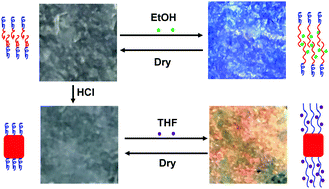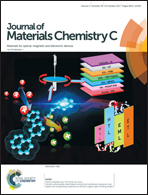A versatile approach to different colored photonic films generated from block copolymers and their conversion into polymer-grafted nanoplatelets†
Abstract
One-dimensional photonic crystals can be formed by the self-assembly of block copolymers. However, such materials are still difficult to make due to the synthetic challenge of making high molecular weight block copolymers and the slow self-assembly characteristics of these block copolymers to form high domain spacings (d > 150 nm). Herein we report a new strategy to construct two different photonic crystals with different solvent responses and reflecting colors from the films of a single block copolymer. Initially, the films made from poly(3-(triethoxysilyl)propyl methacrylate)-block-poly(stearyl methacrylate) with moderate molecular weight (PTEPM666-b-PSMA553) were responsive to alcohol with an observed stop band change from 365 nm (dry film) to 458 nm (film in ethanol), displaying a blue color. After conversion of the PTEPM domain to form SiO2 nanoplatelets, the PSMA553-g-SiO2 nanoplatelet film showed a larger stop band change from 365 nm (dry film) to 591 nm (film in THF), which reflected a bright orange color.



 Please wait while we load your content...
Please wait while we load your content...